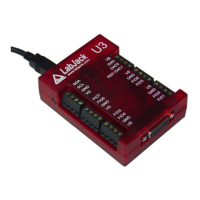to U3 ground (instead of sensor ground). This requires a good understanding of ground
isolation in the system. The LJTick-CurrentShunt is often a simple solution.
Both Figure 2-5 and 2-6 show a 0-100 Ω resistor in series with SGND, which is discussed in
general in Section 2.6.3.4. In this case, if SGND is used (rather than GND), a direct connection
(0 Ω) should be good.
ing and
nel
at labjack.com.
connection) analog input channel can be tough to
redict and is likely to vary with sample timing and adjacent sampled channels. Keep in mind
at a floating channel is not at 0 volts, but rather is at an undefined voltage. In order to see 0
be connected to the input.
ade the input impedance
f the analog input.
0 kΩ resistor should pull the analog input readings to within 50 mV of any
esired voltage, but obviously degrades the input impedance to 100 kΩ. For the specific case
. Although this sensor measures the temperature
side the U3, which is warmer than ambient, it has been calibrated to read actual ambient
e temperature of the entire U3 must stabilize
n take on the order of 1 hour. Best results will be
g
(DAC0 and DAC1) that are available on the screw
rminals. Each analog output can be set to a voltage between about 0.04 and 4.95 volts with
lution. The maximum output voltage is limited by the supply voltage to the U3.
DC
ference, which is not as stable as the internal 2.4 volt reference.
The best way to handle 4-20 mA signals is with the LJTick-CurrentShunt, which is a two chan
active current to voltage converter module that plugs into the U3 screw-terminals. More
information is available
2.6.3.8 Floating/Unconnected Inputs
The reading from a floating (no external
p
th
volts, a 0 volt signal (such as GND) should
Some data acquisition devices use a resistor, from the input to ground, to bias an unconnected
input to read 0. This is often just for "cosmetic" reasons so that the input reads close to 0 with
floating inputs, and a reason not to do that is that this resistor can degr
o
In a situation where it is desired that a floating channel read a particular voltage, say to detect a
broken wire, a resistor can be placed from the AINx screw terminal to the desired voltage (GND,
VS, DACx, ...). A 10
d
of pulling a floating channel to 0 volts, a 1 MΩ resistor to GND can typically be used to provide
analog input readings of less than 50 mV.
2.6.4 Internal Temperature Sensor
he U3 has an internal temperature sensorT
in
temperature. For accurate measurements th
relative to the ambient temperature, which ca
obtained in still air in an environment with slowly changing ambient temperatures.
With the UD driver, the internal temperature sensor is read by acquiring single-ended analo
input channel 30, and returns degrees K.
2.7 DAC
he LabJack U3 has 1 or 2 analog outputsT
te
8-bits of reso
The second analog output is only available in certain configurations. In particular, if the analog
inputs are using the internal 2.4 volt reference (the most accurate option), then DAC1 outputs a
fixed voltage of 1.5*Vref. If DAC1 is enabled, the analog inputs use Vreg (3.3 volts) as the A
re
23

